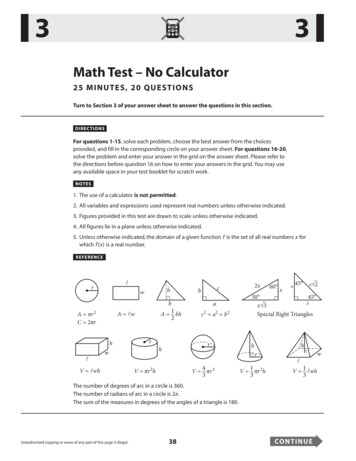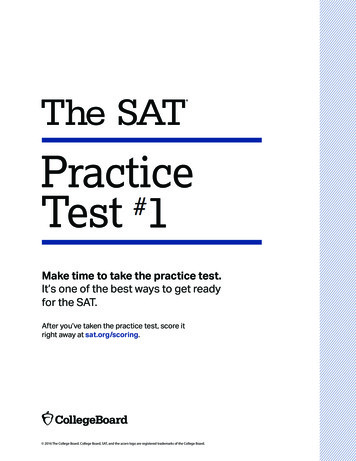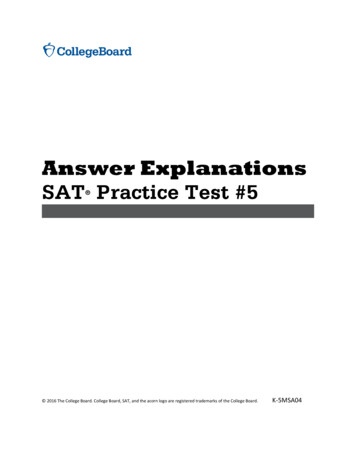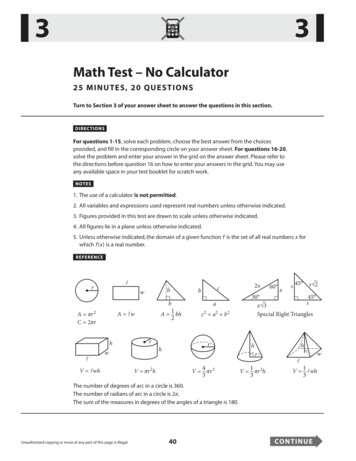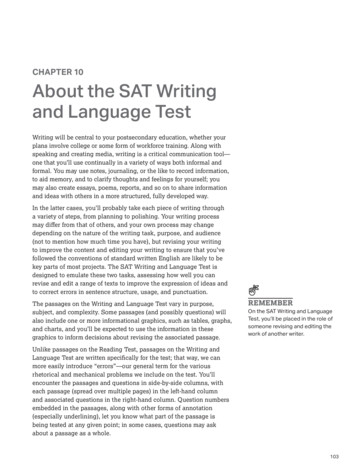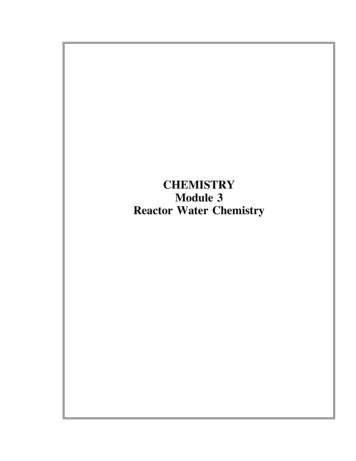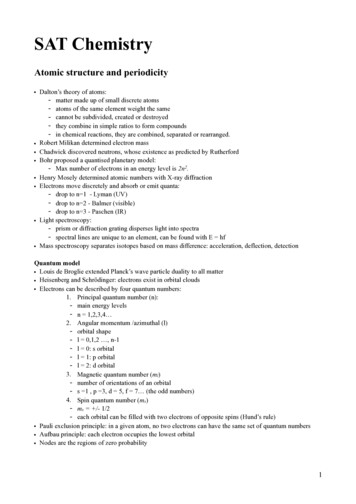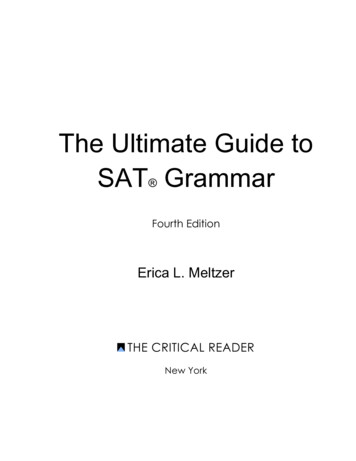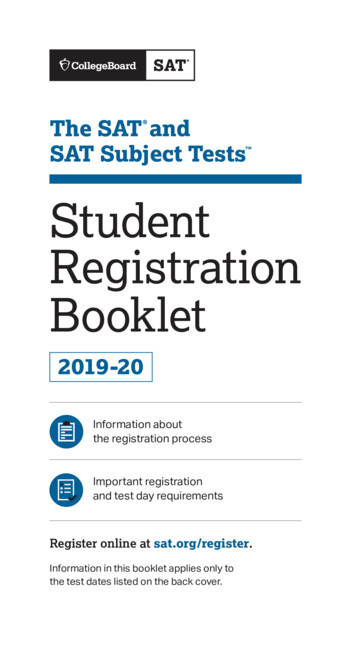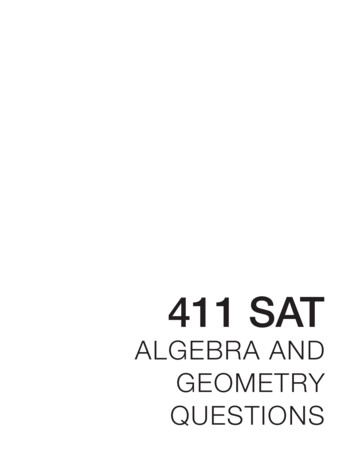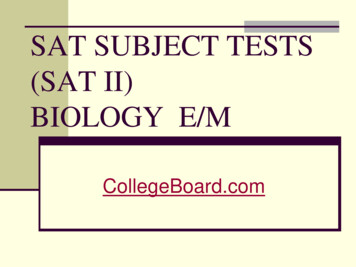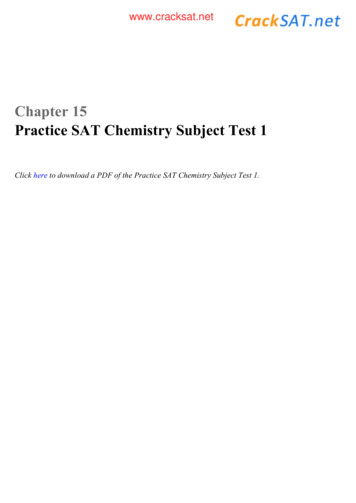
Transcription
www.cracksat.netChapter 15Practice SAT Chemistry Subject Test 1Click here to download a PDF of the Practice SAT Chemistry Subject Test 1.
Useful Links:SAT Online Practice Tests: http://www.cracksat.net/tests/SAT Subjects Tests: http://www.cracksat.net/sat2/SAT Downloads: http://www.cracksat.net/sat-downloads/For more SAT information, please visit http://www.cracksat.netSAT Downloads:SAT real tests -real-tests.htmlSAT official guide tests -official-guide-tests.htmlSAT online course tests -online-course-tests.htmlSAT subject tests -subject-tests.htmlPSAT real tests 0 College Admission Essay essays/
www.cracksat.netPRACTICE SAT CHEMISTRY SUBJECT TEST 1You are about to take the first of three practice SAT Chemistry Subject Tests.After answering questions 1–23, which constitute Part A, you’ll be directed to answerquestions 101–116, which constitute Part B. Then you will begin again at question 24.Questions 24–69 constitute Part C.When you’re ready to score yourself, refer to the scoring instructions and answer key onthis page. Full explanations regarding the correct answers to all questions start on this page.
www.cracksat.netPRACTICE SAT CHEMISTRYMATERIAL IN THE FOLLOWING TABLE MAY BE USEFUL IN ANSWERING THE QUESTIONS IN THIS EXAMINATION.Click here to see full page view
www.cracksat.netCHEMISTRY SUBJECT TEST 1Note: For all questions involving solutions and/or chemical equations, assume that the system is inpure water unless otherwise stated.Part ADirections: Each set of lettered choices below refers to the numbered statements or questionsimmediately following it. Select the one lettered choice that best fits each statement or answerseach question, and then fill in the corresponding oval on the answer sheet. A choice may be usedonce, more than once, or not at all in each set.Questions 1–4 refer to the following.(A) Thermometer(B) Conductivity tester(C) Salt bridge(D) Buret(E) Graduated cylinder1. May be used in combination with a calorimeter to compare the specific heats of twotwo substances2. Is used to measure the volume of a solid by water displacement3. Useful for adding small quantities of acid into a base4. Completes the circuit of an electrochemical cell
www.cracksat.netQuestions 5–9 refer to the following.(A) Nucleic acids(B) Proteins(C) Carbohydrates(D) Lipids(E) Electrolytes5. Always amphoteric in nature6. Found as both straight-chained and branched polymers7. Deoxyribose in DNA nucleotides belongs to this family of biologically importantmolecules8. Always ionic in nature9. Tend not to be water soluble, and aggregate into droplets or molecular bilayers
www.cracksat.netQuestions 10–13 refer to the following.(A) Ag Br– AgBr(B)(C)(D) (E) 2HgO 2Hg O210. Represents the decomposition of a compound into its constituent elements11. Represents alpha decay12. Represents an oxidation-reduction reaction13. Causes the neutron-to-proton ratio in a nucleus to be lowered
www.cracksat.netQuestions 14–16 refer to the following.14. Is the activation energy of the reverse reaction15. Is the enthalpy change of the forward reaction16. Represents energy of the activated complex
www.cracksat.netQuestions 17–20 refer to the following.(A) Hydrogen bonding(B) Ionic bonding(C) Metallic bonding(D) Nonpolar covalent bonding(E) Polar covalent bonding17. Holds a sample of barium iodide, BaI2, together18. Allows solids to conduct electricity19. Attracts atoms of hydrogen to each other in an H2 molecule20. Responsible for relatively low vapor pressure of water
www.cracksat.netQuestions 21–23 refer to the following.(A) Iron(III) chloride, FeCl3(s)(B) Iodine, I2(s)(C) Sodium hydroxide, NaOH(s)(D) Sucrose, C12H22O11(s)(E) Graphite, C(s)21. Gives off a purplish vapor as it sublimes22. Can conduct electricity in the solid state23. Its dissolution in water is highly exothermic
www.cracksat.netPLEASE GO TO THE SPECIAL SECTION LABELED CHEMISTRY AT THE LOWERRIGHT-HAND CORNER OF THE ANSWER SHEET YOU ARE WORKING ON ANDANSWER QUESTIONS 101–116 ACCORDING TO THE FOLLOWING DIRECTIONS.Part BDirections: Each question below consists of two statements, I in the left-hand column and II in theright-hand column. For each question, determine whether statement I is true or false and whetherstatement II is true or false, and fill in the corresponding T or F ovals on your answer sheet. Fill inoval CE only if statement II is a correct explanation of statement 113.
www.cracksat.net114.115.116.RETURN TO THE SECTION OF YOUR ANSWER SHEET YOU STARTED FOR CHEMISTRY AND ANSWER QUESTIONS24–69.
www.cracksat.netPart CDirections: Each of the questions or incomplete statements below is followed by five suggestedanswers or completions. Select the one that is best in each case and then fill in the correspondingoval on the answer sheet.24. What is the number of protons and neutrons in an atom with mass number 89 andand atomic number 39?(A) 50 protons and 50 neutrons(B) 50 protons and 39 neutrons(C) 39 protons and 89 neutrons(D) 39 protons and 50 neutrons(E) 39 protons and 39 neutrons C4H10(g) O2(g) CO2(g) H2O(l)25. When the above equation is balanced using the lowest whole-number terms, thecoefficient of CO2 is(A) 2(B) 4(C) 8(D) 10(E) 1326. Which of the following is closest in mass to a proton?(A) Alpha particle(B) Positron(C) Neutron(D) Electron(E) Hydrogen molecule27. What is the approximate percentage composition by mass of the element oxygen inin the compound HClO4?(A) 16%(B) 32%(C) 50%(D) 64%(E) 75%28. If two atoms that differ in electronegativity combine by chemical reaction and share
www.cracksat.netshare electrons, the bond that joinsthem will be(A) metallic(B) ionic(C) a hydrogen bond(D) nonpolar covalent(E) polar covalent29. When the temperature of a 20-gram sample of water is increased from 10 C to 30 C,30 C, the heat transferred to the water is(A) 600 calories(B) 400 calories(C) 200 calories(D) 30 calories(E) 20 calories30. What is the oxidation state of chromium, Cr, in the compound potassium dichromate,dichromate, K2Cr2O7?(A) 1(B) 2(C) 3(D) 6(E) 1231. An aqueous solution with pH 5 at 25 C has a hydroxide ion (OH–) concentration ofof(A) 1 10–11 molar(B) 1 10–9 molar(C) 1 10–7 molar(D) 1 10–5 molar(E) 1 10–3 molar2H2O(g) 2H2(g) O2(g)32. The volume of water vapor required to produce 44.8 liters of oxygen by the aboveabove reaction is(A) 11.2 liters(B) 22.4 liters(C) 44.8 liters(D) 89.6 liters(E) 100.0 liters
www.cracksat.net33. When 190 grams of MgCl2 are dissolved in water and the resulting solution is 500milliliters in volume, what is the molar concentration of MgCl2 in the solution?(A) 2.0 M(B) 4.0 M(C) 8.0 M(D) 12.0 M(E) 16.0 M34. When a fixed amount of gas has its Kelvin temperature doubled and its pressuredoubled, the new volume of the gas is(A) four times greater than its original volume(B) twice its original volume(C) unchanged(D) one-half its original volume(E) one-fourth its original volume35. In 12.4 hours, a 100 gram sample of an element decays so that its mass is 25 grams.grams. What is the approximate half-life of this radioactive substance?(A) 1.6 hours(B) 3.1 hours(C) 6.2 hours(D) 24.8 hours(E) 49.6 hours36. In the equation Q , the species represented by Q is(A)(B)(C)(D)(E)37. A compound with a molecular weight of 56 amu has an empirical formula of CH2.What is its molecular formula?(A) C2H2(B) C2H4(C) C4H8(D) C4H10(E) C6H12
www.cracksat.net38. The change in heat energy for a reaction is best expressed as a change in(A) enthalpy(B) absolute temperature(C) specific heat(D) entropy(E) kinetic energy NF3(g) H2O(g) HF(g) NO(g) NO2(g)39. When the equation for the reaction above is balanced, how many moles of NF3 wouldwould be required to react completely with 6 moles of H2O?(A) 0.5 mole(B) 1 mole(C) 2 moles(D) 3 moles(E) 4 moles40. Which characteristic is associated with bases?(A) React with metal to produce hydrogen gas(B) Donate an unshared electron pair(C) Always contain the hydroxide ion in their structure(D) Taste sour(E) Formed by the reaction of a nonmetal oxide and water41. An element has the following properties: shiny, brittle, poor electrical conductivity,conductivity, and high melting point. This element can be best classified as a(n)(A) alkali metal(B) halogen(C) metalloid(D) transition metal(E) noble gas42. Which of the following forward processes produces a decrease in entropy?I. H2O(g) H2O(l)II. Fe2 (aq) S2– (aq) FeS(s)2SO2(g) O2(g)III. 2SO3(g)(A) I only(B) III only(C) I and II only
(D) II and III onlywww.cracksat.net(E) I, II, and III43. Which of the following will raise the boiling point of a sample of water?(A) Heat the water(B) Mix gasoline into the water(C) Bring the water sample to a higher altitude(D) Place the water sample on a magnetic stirrer(E) Dissolve table sugar into the water44. Elements H and J lie in the same period. If the atoms of H are smaller than the atomsatoms of J, then compared to atoms of J, atoms of H are most likely to(A) exist in a greater number of isotopes(B) exist in a lesser number of isotopes(C) exist in a greater number of oxidation states(D) have a greater positive charge in their nuclei(E) have a lesser positive charge in their nuclei Al(s) O2(g) Al2O3(s)45. When the equation representing the reaction shown above is completed and balancedbalanced and all coefficients are reduced to lowest whole-number terms, thecoefficient of O2(g) is(A) 1(B) 2(C) 3(D) 4(E) 646. Which of the following solids has a brilliant blue color?(A) Ca(OH)2(B) KCl(C) NaBr(D) Fe2O3(E) CuSO447. Twenty-five percent of element X exists as 210X and 75 percent of it exists as214X. What is the atomic weight of element X in amu?(A) 85(B) 211
www.cracksat.net(C) 212(D) 213(E) 21448. A 600-milliliter container holds 2 moles of O2(g), 3 moles of H2(g), and 1 mole of HeHe(g). Total pressure within the container is 760 torr. What is the partial pressure ofpressure of O2?(A) 127 torr(B) 253 torr(C) 380 torr(D) 507 torr(E) 760 torrFe(OH)3(s)Fe 3 (aq) 3OH–(aq)49. The ionic solid Fe(OH)3 is added to water and dissociates into its component ions, asions, as shown above. The solubility product expression for the saturated solution issolution is(A) Ksp [Fe3 ] [OH–](B) Ksp [Fe3 ] [3OH–](C) Ksp [Fe3 ] [3OH–]3(D) Ksp [Fe3 ] [OH–]3(E) Ksp 50. Which of the following electron configurations represents an atom of magnesium inin an excited state?(A) 1s22s22p6(B) 1s22s22p63s2(C) 1s22s22p53s23p2(D) 1s22s22p63s13p1(E) 1s22s22p63s13p251. All of the following when added to water will produce an electrolytic solutionEXCEPT(A) N2(g)(B) HCl(g)(C) KOH(s)(D) NaI(s)(E) CaCl2(s)
www.cracksat.netNH3 (aq) H2CO3 (aq)NH4 (aq) HCO3– (aq)52. In the reaction represented above, NH4 acts as a(n)(A) indicator(B) hydrate(C) acid(D) base(E) salt53. Which species has the ground state electron configuration 1s22s22p63s23p6?(A) Sulfide ion, S2–(B) Bromide ion, Br–(C) Neon atom, Ne(D) Chromium ion, Cr3 (E) Potassium atom, K54. Which of the following species is amphoteric?(A) Na3PO4(B) HSO4–(C) KOH(D) HNO3(E) C2O2–455. An ideal gas has a volume of 10 liters at 20 C and a pressure of 750 mmHg. WhichWhich of the following expressions is needed to determine the volume of the samesame amount of gas at STP?(A)(B)(C)(D)(E)
www.cracksat.netQuestions 56–57 pertain to the phase diagram for substance Z below.56. Substance Z is at 0.5 atm and 200 K. If the pressure on substance Z is steadilyincreased and its temperature is kept constant, what phase change will eventuallyeventually occur?(A) Condensation(B) Freezing(C) Melting(D) Sublimation(E) Vaporization57. The normal boiling point of substance Z is closest to(A) 100 K(B) 200 K(C) 300 K(D) 400 K(E) 500 K58. The shape of a PCl3 molecule is described as(A) bent(B) trigonal pyramidal(C) linear(D) trigonal planar(E) tetrahedral59. What volume of 0.4 M Ba(OH)2 (aq) is needed to exactly neutralize 100 milliliters of
of 0.2 M HBr(aq)?www.cracksat.net(A) 25 mL(B) 50 mL(C) 100 mL(D) 200 mL(E) 400 mL60. Which of the following is true regarding the aqueous dissociation of HCN, Ka 4.9 4.9 10–10 at 25 C?I. At equilibrium, [H ] [CN–]II. At equilibrium, [H ] [HCN]III. HCN(aq) is a strong acid.(A) I only(B) II only(C) I and II only(D) II and III only(E) I, II, and III61. Which of the following atoms has the largest second ionization energy?(A) Silicon, Si(B) Calcium, Ca(C) Chlorine, Cl(D) Iron, Fe(E) Sodium, Na
www.cracksat.netQuestion 62 refers to the overall reaction and half-reactions with standard reductionpotentials below.2Fe2 Cl2 2Fe3 2Cl Fe3 e– Fe2 ; Eored 0.77 voltsCl2 2e– 2Cl–; Eored 1.36 volts62. The standard potential difference of an electro-chemical cell using the overallreaction above is(A) 0.18 volts(B) 0.59 volts(C) 1.05 volts(D) 2.13 volts(E) 2.90 volts63. The reaction of zinc metal, Zn, and hydrochloric acid, HCl, produces which of thethe following?I. H2(g)II. Cl2(g)III. Zn2 (aq)(A) II only(B) III only(C) I and II only(D) I and III only(E) I, II, and III
www.cracksat.netQuestions 64–66 refer to the following reaction.2H2S(g) 3O2(g)2SO2(g) 2H2O(g) heat64. For the above reaction, the equilibrium concentration of SO2(g) can be increased byby(A) adding neon gas(B) increasing the temperature(C) adding a catalyst(D) increasing the concentration of H2O(g)(E) increasing the concentration of O2(g)65. Which of the following is increased by decreasing the volume of the reaction system?system?I. Rate of reactionII. Equilibrium concentration of reactantsIII. Value of Keq(A) I only(B) III only(C) I and II only(D) II and III only(E) I, II, and IIIFe2O3(s) 3CO(g) 2Fe(s) 3CO2(g)66. When 3 moles of Fe2O3 are allowed to completely react with 56 grams of COaccording to the above equation, approximately how many moles of iron, Fe, areare produced?(A) 0.7(B) 1.3(C) 2.0(D) 2.7(E) 6.0
www.cracksat.net2Na2O2(s) 2H2O(l) 4NaOH(aq) O2(g)67. Sodium peroxide, Na2O2, and water react in the flask at 25 C according to theequation and in the diagram above. If water levels are equal inside and outside thethe beaker, then the gas pressure inside the beaker is equal to the(A) pressure of oxygen gas collected(B) vapor pressure of water at 25 C(C) sum of pressure of oxygen gas collected and atmospheric pressure(D) sum of vapor pressure of water at 25 C and atmospheric pressure(E) sum of pressure of oxygen gas collected and vapor pressure of water at 25 C68. Which of the following molecules has the strongest carbon-to-carbon bond?(A) C2H2(B) C2H4(C) C2H6(D) C3H8(E) C4H10N2O4(g)2NO2(g)The following concentration data were gathered for the above reaction at 5 minuteintervals from the start of an experiment:Time After Start of Experiment[N2O4][NO2]0 min (start)5 min10 min15 min20 min25 min0.00 M0.10 M0.20 M0.25 M0.28 M0.28 M0.50 M0.33 M0.20 M0.15 M0.13 M0.13 M69. If the experiment was carried out in a closed system at constant temperature, thenthen during which time interval (from the start of the experiment) did the reactionreaction most likely achieve equilibrium?(A) 0 min (start) to 5 min
(B) 5 min to 10 minwww.cracksat.net(C) 10 min to 15 min(D) 15 min to 20 min(E) 20 min to 25 minSTOPIf you finish before time is called, you may check your work on this section only.Do not turn to any other section in the test.
www.cracksat.netHOW TO SCORE THE PRINCETON REVIEW PRACTICE SATCHEMISTRY SUBJECT TESTWhen you take the real exam, the proctors will collect your test booklet and bubble sheet and sendyour answer sheet to New Jersey, where a computer looks at the pattern of filled-in ovals on youranswer sheet and gives you a score. We couldn’t include even a small computer with this book, sowe are providing this more primitive way of scoring your exam.Determining Your ScoreSTEP 1Using the answer key on the next page, determine how many questions you got right and how manyyou got wrong on the test. Remember: Questions that you do not answer don’t count as either rightor wrong answers.STEP 2List the number of right answers here.(A)STEP 3List the number of wrong answers here. Now divide that number by 4. (Use a calculator if you’refeeling particularly lazy.)(B) 4 (C)STEP 4Subtract the number of wrong answers divided by 4 from the number of correct answers. Roundthis score to the nearest whole number. This is your raw score.A) – (C) STEP 5To determine your real score, take the number from Step 4 above, and look it up in the left columnof the Score Conversion Table on this page; the corresponding score on the right is your score onthe exam.
www.cracksat.netANSWERS TO THE PRINCETON REVIEW PRACTICE SATCHEMISTRY SUBJECT TEST 1
www.cracksat.netTHE PRINCETON REVIEW PRACTICE SAT CHEMISTRYSUBJECT TEST SCORE CONVERSION TABLE
CHEMISTRY SUBJECT TEST 1 Note: For all questions involving solutions and/or chemical equations, assume that the system is in pure water unless otherwise stated. Part A Directions: Ea

